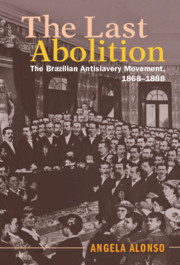Book contents
- The Last Abolition
- Afro-Latin America
- The Last Abolition
- Copyright page
- Dedication
- Contents
- Figures
- Maps
- Tables
- Acknowledgments
- Abbreviations
- Introduction
- 1 Elite Abolitionism
- 2 Pro-Slavery Rhetoric
- 3 The Moral Repertoire of Abolitionism
- 4 The Theatricalization of Politics
- 5 Expansion
- 6 Results-Based Abolitionism
- 7 Votes: A Movement/Government Alliance
- 8 Bullets: Movement and Countermovement
- 9 The March to Victory
- 10 Future of the Preterite
- 11 Abolitionism as a Social Movement
- Annex
- Bibliography
- Index
11 - Abolitionism as a Social Movement
Published online by Cambridge University Press: 24 September 2021
- The Last Abolition
- Afro-Latin America
- The Last Abolition
- Copyright page
- Dedication
- Contents
- Figures
- Maps
- Tables
- Acknowledgments
- Abbreviations
- Introduction
- 1 Elite Abolitionism
- 2 Pro-Slavery Rhetoric
- 3 The Moral Repertoire of Abolitionism
- 4 The Theatricalization of Politics
- 5 Expansion
- 6 Results-Based Abolitionism
- 7 Votes: A Movement/Government Alliance
- 8 Bullets: Movement and Countermovement
- 9 The March to Victory
- 10 Future of the Preterite
- 11 Abolitionism as a Social Movement
- Annex
- Bibliography
- Index
Summary
This book argued that the Brazilian antislavery mobilization proved to be a national social movement. The movement chose strategies according to a shifting balance of power, giving to the government´s tolerance or repression, the availability of allies, and the pro-slavery countermovement´s strength. This relational dynamic movement/state/countermovement forced abolitionists to favor successful demonstrations in the public space, field candidates for political institutions, and civil disobedience.Three mechanisms explain the geographical expansion and continuity of Brazilian abolitionism through two decades: the building up of national activism networks, portable activism styles (easily reproducible political performances) and political brokers (the key broker was André Rebouças). Brazilian abolitionists relied on a repertoire of former antislavery movements and adapted it to local political traditions. Givem the formal link between church and State in Brazil, abolitionists used secular rhetoric and theater as propaganda. In this sense, it was more modern than the somewhat religiously embedded Anglo-Saxon abolitionism. This study shows civil society mobilization was not a particular feature of Anglo-American abolitionism. Besides, it demonstrated the placement of national actors in a global network of activism, making a case for including Brazil in the transnational history of abolitionism.
- Type
- Chapter
- Information
- The Last AbolitionThe Brazilian Antislavery Movement, 1868–1888, pp. 352 - 362Publisher: Cambridge University PressPrint publication year: 2021



